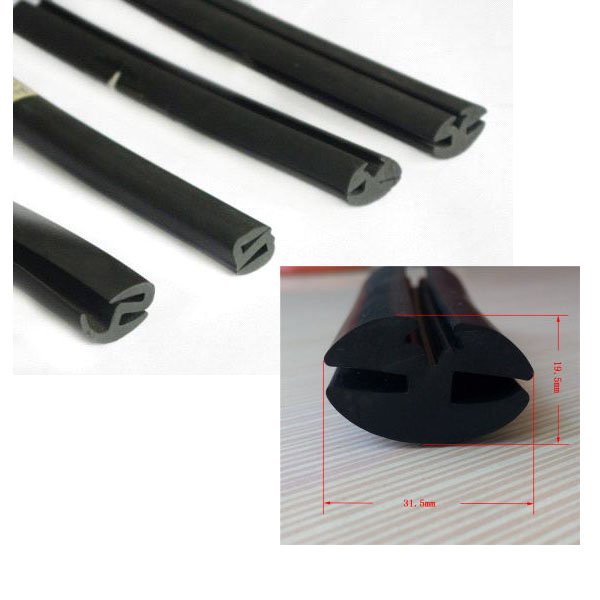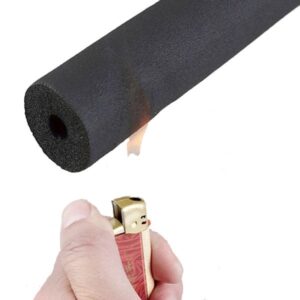We often need rubber components in many things around us. We may find the use of various rubber components or various machinery in our living space. In this case, rubber seal strips, gaskets, hoses, and sheets are the most popular. Now, when it comes to rubber products, we may find various types of them. For example, EPDM, Nitrile, Neopre, Viton, and many more are noteworthy. However, EPDM vs NBR rubber is a widespread discussion on the internet. Considering the importance of this topic, we prepared this article in brief.
We should understand the differences between NBR and EPDM rubber for several reasons:
- It helps you identify the ideal product for a project.
- The right rubber product ensures the efficiency of a system.
- The right rubber type provides prolonged durability, reducing a system’s downtime.
Most importantly, understanding the differences helps you do the maintenance properly.
The article mainly highlights the fundamental differences between EPDM and NBR Rubber. It covered enough knowledge, starting from their properties to diverse applications. It ensures that our readers get sufficient information to identify the best choice for their projects. Above all, this article will be a masterpiece for you to choose between EPDM and NBR Rubber.
EPDM vs. NBR Rubber
Both EPDM and NBR Rubber offer unique benefits. Hence, we can find them in the specific type of applications. The primary difference between EPDM and NBR is their ability to withstand environmental factors. These environmental factors include weather, certain liquids, gases, and the atmosphere. For example, EPDM is excellent for weather and UV resistance. However, it is not suitable for use in oil and gas containers. On the other hand, NBR is ideal for oil and gas uses but unsuitable for weather, UV, or ozone-resisting applications.
Besides this, there are other minor differences. We summarized the primary differences between NBR and EPDM Rubber in the following.
| Factors | EPDM Rubber | NBR Rubber |
| Material composition | Ethylene, Propylene, Diene Monomer | Acrylonitrile, Butadiene |
| EPDM vs NBR Temperature | 50°C to +120°/150°C (-60°F to +250°/300°F) | -35°C to +120°C (-30°F to +250°F) |
| EPDM vs NBR Rubber Flexibility | Less flexible than NBR rubber seals | More flexible than EPDM Rubber |
| Hardness, Shore A | 30 – 90 with tensile failure stress of 17 MPa or 500 PSI– 2500 PSI | Same as EPDM Rubber |
| NBR vs EPDM Rubber Resistance to Various Factors | Excellent in weather, UV, and Ozone resistance | Moderate in weather, UV, and ozone resistance |
| EPDM vs NBR Chemical Resistance | Moderate in Chemical and Oil Resistance | Excellent in Chemical and Oil Resistance |
| Nitrile vs EPDM Electric insulation | Moderate electric insulation | Fair or poor electric insulation |
| Common applications | Roofing, automotive, electrical insulation, weather stripping | Seals, gaskets, hoses, oil and gas |
EPDM Rubber
EPDM stands for Ethylene Propylene Diene Monomer. It is a synthetic rubber compound that offers a unique composition and structure. The manufacturing process includes polymerization for those three materials. The result is a versatile rubber material famous for its exceptional properties and wide range of applications. Popular EPDM rubber products include EPDM rubber seal, EPDM tubing, EPDM hose, and EPDM sheet. These high-quality EPDM products come from the EPDM extrusion process.
EPDMS’s unique structure arises from the random arrangement of its polymer chains. This particular arrangement gives EPDM its excellent flexibility and resistance to cracking. It helps operate even at low temperatures. In addition, the presence of diene monomer allows for cross-linking during vulcanization. It contributes to stiffness and enhances the inhibitory impact on diffusion properties.

Properties of EPDM Rubber
EPDM rubber boasts a wide array of physical and chemical properties. These properties make EPDM highly desirable in various applications. EPDM provides excellent weather resistance, including UV radiation, ozone, and extreme temperatures. For instance, EPDM rubber can operate in hot water and steam up to +150 degrees Celcius. For some unique materials, it may increase up to +180 degrees.
EPDM provides good resistance to some mild chemicals. It may not be suitable for use in chemical applications. However, EPDM rubber is a reasonable electrical insulator. This characteristic makes them ideal for electrical insulation applications. Moreover, EPDM does not discolor or stain other materials.
What Are The Practical Uses of EPDM?
EPDM rubber finds widespread use in various industries and applications. Its unique combination of properties makes them highly recommended for these applications. Some of the practical services of EPDM include:
- Roofing: EPDM is famous for flat and low-slape roofing systems. Its resistance capability makes it an excellent choice for protection against various elements.
- HVAC Systems: EPDM seals and gaskets are used in heating, ventilation, and air conditioning systems. They ensure efficient and leak-free operation.
- Automotive: EPDM is used extensively in the automotive industry for seals, hoses, and weather stripping. Its resistance to temperature extremes, chemicals, and weather makes it valuable in this sector.
- Outdoor playground surface: EPDM granules provide cushioning and safety for children and athletes. As a result, it is commonly seen on playground surfaces and sports fields.
- Pond liners and geomembranes: Pond liners are necessary to prevent leaks and protect pond structure. EPDM rubber helps line ponds, lakes, and other water containment structures in this case. It is also employed in landfill liners and agricultural irrigation ponds.
- Marine Industry: EPDM rubber is also prevalent in the marine industry for boat rub rails and dock bumpers. It is also used in other sealing applications due to its resistance to saltwater and harsh marine conditions.
Pros And Cons of EPDM Rubber
| Pros | Cons |
| Excellent weather resistance, such as sunlight, ozone, or UV | Not suitable for use in oil and gas applications |
| Longevity and durability | Moderate Chemical resistance |
| Flexible and elastic | EPDM provides relatively lower strength than NBR Rubber sealing. |
| Suitable for high-temperature applications | It tends to swell in petroleum-based fluids. |
| Low maintenance required | Limited flame resistance |
| Environmentally friendly | |
| It is mainly used for weather-stripping sealing in buildings, automobiles, and containers. |
NBR Rubber
NBR stands for Nitrile Butadiene Rubber. It is also commonly referred to simply as nitrile rubber. It is also a synthetic elastomer that belongs to the family of copolymers. The manufacturing process involves polymerization of acrylonitrile and butadiene using a catalyst. Acrylonitrile or ACN content in NBR rubber varies from 18% to 50%. On the other hand, butadiene is the second monomer in the polymerization process. Now, in the presence of a catalyst (usually a metal compound), the polymerization process creates NBR rubber.
NBR Rubber is characterized by its unique composition and structure. It gives NBR valuable properties and a versatile material for various applications.

Properties of Nitrile Rubber
NBR, or Nitrile rubber, exhibits a wide range of physical and chemical properties. These properties make it highly desirable in various applications. Firstly, NBR is well known for its exceptional resistance to oils, fuels, and hydrocarbons. As a result, it is a preferred choice in the automotive, oil, and gas industry. Secondly, NBR rubber remains flexible over a broad temperature range from -35°C to +120°C (-30°F to +250°F). This flexibility ensures that NBR rubber can adapt to different environmental conditions.
Moreover, NBR has good tensile strength. It can withstand stretching and pulling forces without tearing. Moreover, NBR rubber also offers food resistance to abrasion. It makes NBR rubber suitable for seals and gaskets subjected to mechanical stress.
What Are The Practical Uses of NBR Rubber?
NBR rubber, or Nitrile rubber, is widely used across various industries due to its unique properties. Some practical applications of NBR rubber include:
- Automotive: NBR rubber is prevalent in making seals, gaskets, hoses, and fuel systems for various automobiles.
- Oil and Gas: NBR rubber seals in equipment and pipelines prevent exposure to hydrocarbons.
- Industrial sealing: NBR rubber is used for sealing applications in this field. It is mainly found in machinery and hydraulic systems.
- Agriculture: NBR rubber protects agricultural machinery from various agricultural chemicals.
- Medical and healthcare: NBR rubber is used in medical gloves and other disposable medical products.
- Construction: Nitrile seal strips, seals, pipes, and hoses are trendy in this field. NBR’s high tensile strength makes it ideal for construction applications.
- Consumer products like footwear, kitchen appliances, rubber hoses, and many more are noteworthy.
Pros And Cons of NBR Rubber
| Pros | Cons |
| Suitable for tear and abrasion resistance | NBR is not suitable for weather resistance. Various weather factors include ozone, sunlight, or UV. |
| Good for water and non-polar solvent resistance | Not suitable for flame resistance |
| Less expensive than fluoroelastomers like Viton, Dynein, Aflas, etc. | Inadequate for high-temperature applications |
| Offers high tensile strength, flexibility, and elasticity | |
| Durable and long-lasting | |
| Effective in oil and gas applications |
Summary
In conclusion, we have reviewed the EPDM vs NBR Rubber Guide and learned some fundamental differences. We knew that both materials offer unique properties suitable for specific applications. In addition, we understood the pros and cons of each rubber type. EPDM rubber is exceptionally ideal for weather resistance, UV resistance, and versatility. It finds application in construction, automotive, and outdoor. On the other hand, NBR Rubber or nitrile rubber is suitable for use in various solvents and gases. Its properties make it ideal for the automotive, oil, and gas industries.
When should we choose EPDM or NBR rubber? The answer lies in the specific demands of your application. If it needs a durable, weather-resistant material, EPDM is the winner. However, NBR rubber takes the lead for oil and chemical resistance applications. Above all, by understanding this article, we can decide which rubber material suits our application needs.
Afterward, please get in touch with our customer service team. You can get a quick response to your queries regarding rubber products and their different types. Seashore Rubber is one of the world’s largest rubber seal strip manufacturers. You can get the best quality products at a reasonable NBR and EPDM rubber price. We maintain the quality of our products and also reliable customer service. For any query, you are welcome to our portal.
